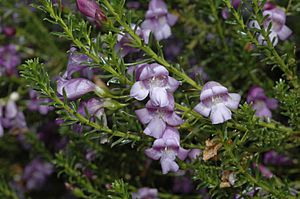Eremophila sargentii facts for kids
Eremophila sargentii is a cool flowering plant that belongs to the figwort family. You can only find it in Western Australia, which means it's endemic there. It's a type of shrub that feels sticky and looks shiny. It has small leaves and pretty flowers that are usually mauve or blue.
Quick facts for kids Eremophila sargentii |
|
|---|---|
 |
|
| Conservation status | |
| Scientific classification | |
| Genus: |
Eremophila (plant)
|
| Species: |
sargentii
|
| Synonyms | |
|
|
Contents
What it Looks Like
Eremophila sargentii is a shrub that has a strong smell. It can grow to be about 0.9 to 2 meters (3 to 7 feet) tall. Its branches are smooth, shiny, and sticky. They also have ridges that run down from where the leaves attach.
The leaves are long and narrow, like a line or an oblong shape. They are about 2 to 6.5 millimeters (0.08 to 0.26 inches) long and 0.5 to 1.5 millimeters (0.02 to 0.06 inches) wide. The leaves are smooth, sticky, and shiny. This shininess comes from a sticky substance called resin on them.
Flowers and Fruits
The flowers grow one by one where the leaves meet the stem. They are on straight, smooth, and sticky stalks that are 3 to 9 millimeters (0.12 to 0.35 inches) long. Each flower has five green, sticky sepals, which are like small leaves that protect the bud. These sepals are about 2 to 3.5 millimeters (0.08 to 0.14 inches) long.
The petals are 9 to 15 millimeters (0.35 to 0.59 inches) long. They are joined together at the bottom to form a tube shape. This petal tube is usually mauve, blue, or lilac. Inside, it's white with yellow-brown spots. The outside of the tube and the petal tips are smooth. But the inside of the tube has long, soft hairs. There are four stamens (the parts that make pollen) hidden inside the petal tube.
This plant usually flowers between September and October. After the flowers, it grows fruits. These fruits are dry, woody, and oval-shaped. They are about 3 millimeters (0.12 inches) long.
How it Got its Name
This plant was first officially described in 1921. A scientist named Spencer Le Marchant Moore gave it the name Pholidia sargentii. He wrote about it in a science paper called Journal of Botany, British and Foreign.
Later, in 1981, another scientist named Robert Chinnock changed its name to Eremophila sargentii. He published this new name in the Journal of the Adelaide Botanic Garden. The second part of its name, sargentii, honors Oswald Hewlett Sargent. He was a pharmacist and botanist from York. He discovered and described nine different plant species.
Where it Lives
This type of eremophila plant grows in sandy loam (a type of soil) and laterite (a reddish soil). You can find it between Wongan Hills and Kalannie. This area is part of the Avon Wheatbelt biogeographic region, which is a way to divide Australia into natural areas.
Protecting the Plant
The Western Australian Government Department of Parks and Wildlife has a special list for plants that need protection. E. sargentii is on this list as "Priority Two". This means that not much is known about it, and it's only found in one or a few places. So, it's important to keep an eye on it and protect its habitat.
Growing it in Gardens
This plant is very tough and easy to grow in gardens. It often has deep blue flowers that look great against its bright green leaves, which sometimes smell nice. Gardeners usually grow new plants from cuttings (small pieces of the plant).
Eremophila sargentii grows well in many different types of soil. This includes soils that are alkaline (like chalky soils) or clay-based. It can handle both dry weather (drought hardy) and cold temperatures (frost hardy). You usually don't need to water it, even if there hasn't been much rain for a long time.


